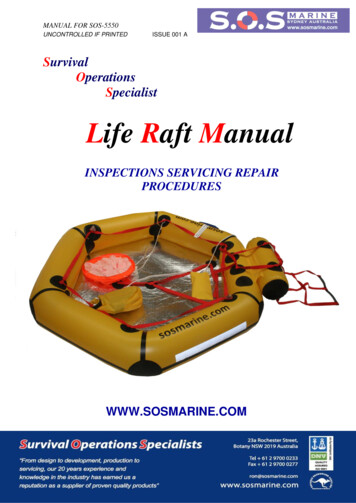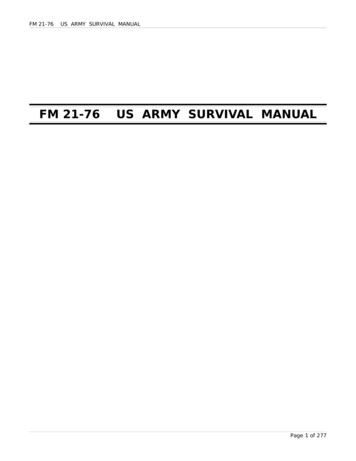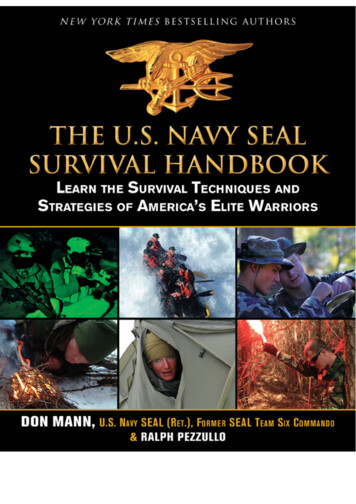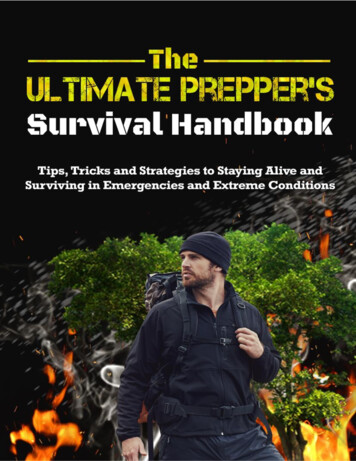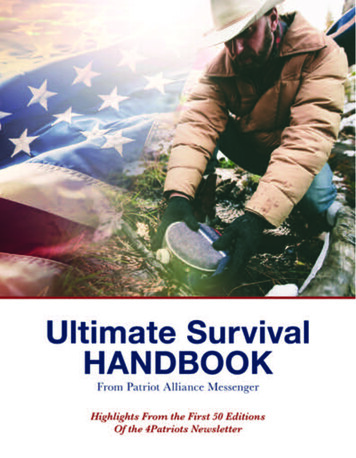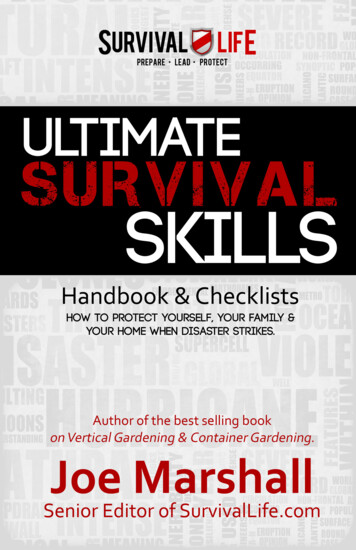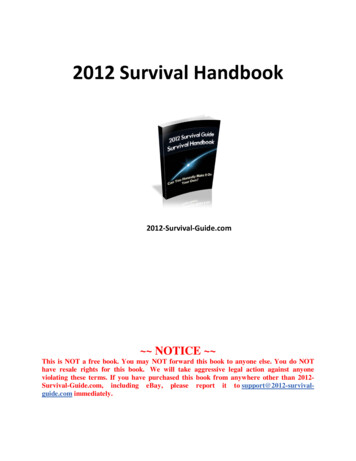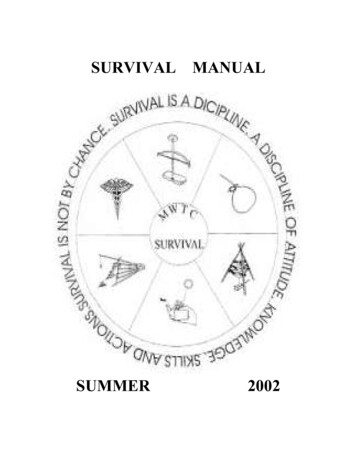
Transcription
SURVIVAL MANUALSUMMER2002
UNITED STATES MARINE CORPSMountain Warfare Training CenterBridgeport, CA. 93517-5001SUMMER SURVIVAL COURSEHANDBOOKTABLE OF 6.CONTENTSREQUIREMENTS FOR SURVIVALSURVIVAL KITWATER PROCUREMENTEXPEDIENT SHELTERS & FIRESCORE VALUES & MOUNTAIN LEADERSHIP CHALLENGESSIGNALING & RECOVERYSURVIVAL NAVIGATIONSURVIVAL TRAPS & SNARESSURVIVAL USES OF GAMEEXPEDIENT TOOLS, WEAPONS AND EQUIPMENTFORAGING FOR PLANTS & INSECTS FOR SURVIVAL USESSURVIVAL FISHINGTRACKINGSURVIVAL MEDICINEMOUNTAIN WEATHERINTRO TO EVASIONAPPENDIXESABCDEFEVASION PLAN OF ACTION (EPA)PME VIDEO “THE EDGE”SURVIVAL QUICK REFERENCE CHECK LISTANIMAL HABITSTACTICAL CONSIDERATIONSGRADING STANDARDS
UNITED STATES MARINE CORPSMountain Warfare Training CenterBridgeport, California 93517-5001MSVX.02.0102/06/05STUDENT HANDOUTREQUIREMENTS FOR SURVIVALTERMINAL LEARNING OBJECTIVE In a survival situation, and given a survival kit,apply the requirements for survival, in accordance with the references. (MSVX.02.01)ENABLING LEARNING OBJECTIVES(1) Without the aid of references and given the acronym “SURVIVAL”, describe inwriting the acronym “SURVIVAL”, in accordance with the references. (MSVX.02.01a)(2) Without the aid of references, list in writing the survival stressors, in accordance withthe references. (MSVX.02.01b)(3) Without the aid of references, list in writing the priorities of work in a survivalsituation, in accordance with the references. (MSVX.02.01c)(4) Without the aid of references, conduct the priorities of work in a survival situation, inaccordance with the references. (MSVX.02.01d)OUTLINE1. REQUIREMENTS FOR SURVIVALa. This positive mental "mind-set" is important in many ways. We usually call it the"will to survive" although you might call it "attitude" as well. This basically meansthat, if you do not have the right attitude, you may not survive.b. A guideline that can assist you is the acronym " SURVIVAL". (MSVX.02.01a)(1) Size up.(a) Size up the situation.1. Conceal yourself from the enemy.01-1MSVX.02.01
2. Maintain your wits and use your senses to determine what ishappening in your immediate area of influence before making asurvival plan.(b) Size up your surroundings.1. Determine the rhythm or pattern of the area.2. Note animal and bird noises and their movement.3. Note enemy traffic and civilian movement.(c) Size up your physical condition.1. Check your wounds and give yourself first aid.2. Take care to prevent further bodily harm.3. Evaluate your condition and the condition of your unit prior todeveloping a plan.(d) Size up your equipment.1. Consider how available equipment may affect survival senses;tailor accordingly.(2) Undue haste makes waste.(a) Plan your moves so that you can move out quickly withoutendangering yourself if the enemy is near.(3) Remember where you are.(a) If you have a map, spot your location and relate it to the surroundingterrain.(b) Pay close attention to where you are and where you are going.Constantly orient yourself.(c) Try to determine, at a minimum, how your location relates to thefollowing:1. The location of enemy units and controlled areas.2. The location of friendly units and controlled areas.01-2MSVX.02.01
3. The location of local water sources.4. Areas that will provide good cover and concealment.(4) Vanquish fear and panic.(a) The feeling of fear and panic will be present. The survivor mustcontrol these feelings.(5) Improvise and Improve.(a) Use tools designed for one purpose for other applications.(b) Use objects around you for different needs. (i.e. use a rock for ahammer)(6) Value living.(a) Place a high value on living.(b) Refuse to give into the problem and obstacles that face you.(c) Draw strength from individuals that rise to the occasion.(7) Act like the natives.(a) Observe the people in the area to determine their daily eating, sleeping,and drinking routines.(b) Observe animal life in the area to help you find sources of food andwater.NOTES: Remember that animal reactions can reveal your presence to the enemy.Animals cannot serve as an absolute guide to what you can eat and drink.(8) Live by your wits, but for now, learn basic skills.(a) Practice basic survival skills during all training programs andexercises.2. STRESS. Stress has many positive benefits. Stress provides us with challenges: it gives uschances to learn about our values and strengths. Too much stress leads to distress. Whilemany of these signs may not be self-identified, it remains critical that all survivors remainattentive to each other's signs of distress. Listed are a few common signs of distress foundwhen faced with too much stress:01-3MSVX.02.01
a. Difficulty in making decisions. (Do not confuse this sign for a symptom ofhypothermia).b. Angry outbursts.c. Forgetfulness.d. Low energy level.e. Constant worrying.f. Propensity for mistakes.g. Thoughts about death or suicide.h. Trouble getting along with others.i. Withdrawing from others.j. Hiding from responsibilities.k. Carelessness.3. SURVIVAL STRESSORS. (MSVX.02.01b). Any event can lead to stress. Often, stressfulevents occur simultaneously. These events are not stress, but they produce it and are called"stressors". In response to a stressor, the body prepares to either "fight or flight". Stressorsadd up. Anticipating stressors and developing strategies to cope with them are the twoingredients in the effective management of stress. It is essential that the survivor be aware ofthe types of stressors they will encounter.a. Injury, Illness, or Death. Injury, illness, and death are real possibilities a survivormay face. Perhaps nothing is more stressful than being alone in an unfamiliarenvironment where you could die from hostile action, an accident, or from eatingsomething lethal.b. Uncertainty and Lack of Control. Some people have trouble operating in settingswhere everything is not clear-cut. This uncertainty and lack of control also add to thestress of being ill, injured or killed.c. Environment. A survivor will have to contend with the stressors of weather, terrainand the types of creatures inhabiting an area. Environmental and climactic changes,coupled with insects and animals, are just a few of the challenges awaiting the Marineworking to survive.d. Hunger and Thirst. Without food and water a person will weaken and eventually die.Getting and preserving food and water take on increasing importance as the length of01-4MSVX.02.01
time in a survival situation increases. With the likelihood of diarrhea, replenishingelectrolytes becomes critical. For a Marine used to having his provisions issued,foraging can be a significant source of stress.e. Fatigue. It is essential that survivors employ all available means to preserve mentaland physical strength. While food, water and other energy builders may be in shortsupply, maximizing sleep to avoid deprivation is a very controllable factor. Further,sleep deprivation directly correlates with increased fear.f. Isolation. Being in contact with others provides a greater sense of security and afeeling someone is available to help if problems occur.4. NATURAL REACTIONS. Man has been able to survive many changes in his environmentthroughout the centuries. His ability to adapt physically and mentally to a changing worldkeeps him alive. The average person will have some psychological reactions in a survivalsituation. These are some of the major internal reactions you might experience within asurvival situation:a. Fear. Fear is our emotional response to dangerous situations that we believe have thepotential to cause death, injury or illness. Fear can have a positive effect if it forces usto be cautious in situations where recklessness could result in injury.b. Anxiety. Anxiety is an uneasy, apprehensive feeling we get when faced withdangerous situations. A survivor reduces his anxiety by performing those tasks thatwill ensure his coming through the ordeal alive.c. Anger and Frustration. Frustration arises when a person is continually thwarted in hisattempts to reach a goal. One result of frustration is anger. Getting lost, damaging orforgetting equipment, weather, inhospitable terrain, enemy patrols and physicallimitations are just a few sources of frustration and anger. Frustration and angerencourage impulsive reactions, irrational behavior, poorly thought-out decisions, andin some instances, an "I quit" attitude.d. Depression. Depression is closely linked with frustration and anger when faced withthe privations of survival. A destructive cycle between anger and frustration continuesuntil the person becomes worn down-physically, emotionally and mentally. At thispoint, he starts to give up, and his focus shifts from "What can I do" to "There isnothing I can do."e. Loneliness and Boredom. Man is a social animal and enjoys the company of others.Loneliness and boredom can be another source of depression. Marines must find waysto keep their minds productively occupied.f. Guilt. The circumstances leading to your survival situation are sometimes dramaticand tragic. It may be the result of an accident or military action where there was aloss of life. Perhaps you were the only, or one of a few, survivors. While naturally01-5MSVX.02.01
relieved to be alive, you simultaneously may be mourning the deaths of others whowere less fortunate. Do not let feelings of guilt prevent you from living.5. PRIORITIES OF WORK IN A SURVIVAL SITUATION. (MSVX.02.02c). Eachsurvival situation will have unique aspects that alter the order in which tasks need to beaccomplished. A general guideline is to think in blocks of time.a. First 24 hours. The first 24 hours are critical in a survival situation. You must makean initial estimate of the situation. Enemy, weather, terrain, time of day and availableresources will determine which tasks need to be accomplished first. They should bethe following:(1) Shelter.(2) Fire.(3) Water.(4) Signaling.b. Second 24 hours. After the first 24 hours have passed, you will now know if you cansurvive. This time period needs to be spent on expanding your knowledge of the area.By completing the following tasks, you will be able to gain valuable knowledge.(1) Tools and weapons. By traveling a short distance from your shelter to locatethe necessary resources, you will notice edible food sources and game trails.(2) Traps and snares. Moving further away from your shelter to employ traps andsnares, you will be able to locate your shelter area from various vantagepoints. This will enable you to identify likely avenues of approach into yourshelter area.(3) Pathguards. Knowing the likely avenues of approaches, you can effectivelyplace noise and casualty producing pathguards to ensure the security of yourshelter area.c. Remainder of your survival situation. This time is spent on continuously improvingyour survival situation until your rescue.6. GROUP SURVIVAL. Group survival depends largely on the ability to organize activity. Anemergency situation does not bring people together for a common goal initially; rather, themore difficult and confusing the situation, the greater are the group’s problems.a. Groups Morale. High morale must come from internal cohesiveness and not merelythrough external pressure. The moods and attitudes can become wildly contagious.01-6MSVX.02.01
Conscious, well-planned organization and leadership on the basis of delegated orshared responsibility often can prevent panic. High group morale has manyadvantages.(1) An individual feels strengthened and protected since he realizes that hissurvival may depend on others whom he trusts.(2) The group can meet failure with greater persistency.(3) The group can formulate goals to help each other face the future.b. Factors that Influence Group Survival. There are numerous factors that will influencewhether a group can successfully survive.(1) Organization of Manpower - Organized action is important to keep allmembers of the group informed; this way the members of the group will knowwhat to do and when to do it, both under ordinary circumstances and inemergencies.(2) Selective Use of Personnel - In well-organized groups, the person often doesthe job that most closely fits his personal qualifications.(3) Acceptance of Suggestion and Criticisms - The senior man must acceptresponsibility for the final decision, but must be able to take suggestion andcriticisms from others.(4) Consideration of Time - On-the-spot decisions that must be acted uponimmediately usually determine survival success.(5) Check Equipment - Failure to check equipment can result in failure to survive.(6) Survival Knowledge and Skills - Confidence in one's ability is increased byacquiring survival knowledge and skills.REFERENCE:1. FM 21-76, Survival, 1992.2. MCRP 3-02h, Survival, Escape, and Evasion, 1999.3. B-GA-217-001/PT-001, Down but not out, Canadian Survival Guide.4. AFM 64-5, Search and Rescue Survival,1969.01-7MSVX.02.01
UNITED STATES MARINE CORPSMountain Warfare Training CenterBridgeport, California 93517-5001MSVX.02.0202/06/05STUDENT HANDOUTSURVIVAL KITTERMINAL LEARNING OBJECTIVE Without the aid of references, and given an area ofoperations, construct a personal survival kit, in accordance with the references. (MSVX.02.02)ENABLING LEARNING OBJECTIVES(1) Without the aid of references, list in writing the components for a survival kit, inaccordance with the references. (MSVX.02.02a)(2) Without the aid of references, list in writing one example of each component for asurvival kit, in accordance with the references. (MSVX.02.02b)OUTLINE1. COMPONENTS FOR A SURVIVAL KITa. The environment is the key to the types of items you will need in your survival kit.How much equipment you put in your kit depends on how you will carry the kit. A kiton your body will have to be much smaller than one carried in a vehicle.b. Always layer your survival kit, keeping the most important items on your body.c. In preparing your survival kit, select items that can be used
summer survival course handbook table of contents chap. contents 1. requirements for survival 2. survival kit 3. water procurement 4. expedient shelters & fires
